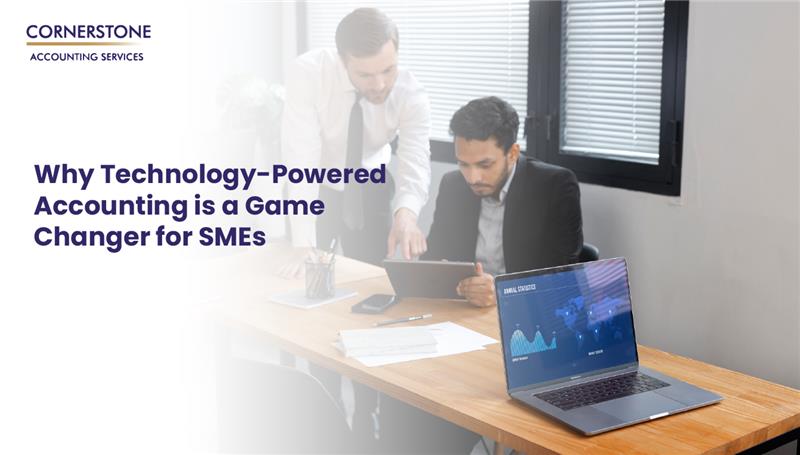Introduction: The New Era of SME Accounting
For many small and medium-sized enterprises (SMEs) in Australia, accounting has long been one of the most stressful and time-consuming parts of running a business. Between managing payroll, tracking expenses, lodging BAS and GST, and meeting Australian Taxation Office (ATO) deadlines, business owners often feel buried in paperwork.
But things are changing fast. Thanks to cloud-based systems, automation tools, and digital bookkeeping platforms, accounting is no longer just a compliance task – it’s becoming a growth driver. By reducing errors, cutting costs, and providing real-time financial visibility, technology-powered accounting is transforming the way SMEs operate.
In this blog, we’ll explore why adopting modern accounting technology is a game-changer for SMEs in Australia, and how it makes tax compliance, cash flow, and decision-making easier than ever.
The Challenges SMEs Face in Accounting
Running an SME is no small task, and accounting often feels like a burden. Common challenges include:
- Limited resources: Most SMEs don’t have in-house finance teams and rely on part-time bookkeepers or external accountants.
- ATO compliance complexity: Tax laws (GST, BAS, PAYG, Superannuation) can be overwhelming.
- Time pressure: Owners juggle multiple responsibilities, leaving little time for proper record-keeping.
- High risk of errors: Manual data entry often leads to costly mistakes during audits.
- Cash flow uncertainty: Without strong forecasting tools, predicting cash flow cycles is difficult.
No wonder many business owners see accounting as a headache rather than a strategic advantage.
What is Technology-Powered Accounting?
Technology-powered accounting uses digital tools like cloud platforms, automation software, and smart bookkeeping apps to replace manual processes.
Instead of spending hours on spreadsheets, SMEs can:
- Automatically reconcile bank transactions.
- Categorise expenses in real-time.
- Generate GST and BAS reports instantly.
- Manage payroll and superannuation with ease.
- Access live dashboards for financial insights.
In short, technology helps SMEs spend less time on admin and more time growing their business.
Benefits of Accounting Technology for SMEs
1. Increased Accuracy
Manual bookkeeping is prone to mistakes. Automation ensures invoices, expenses, and tax records are accurate and audit-ready, giving business owners peace of mind.
2. Time Savings
Tasks like reconciling accounts, preparing BAS, and running payroll can take days when done manually. With automation, they’re completed in minutes.
3. Cost Efficiency
Hiring a full-time accountant can be expensive. With digital accounting, SMEs can handle daily operations in-house and reserve accountants’ expertise for strategic planning.
4. Simplified Tax Compliance
Tax season no longer needs to be stressful. Accounting software:
- Tracks GST and BAS automatically.
- Sends reminders for lodgement deadlines.
- Flags missing records or discrepancies.
- Stores e-receipts and invoices for easy audits.
5. Real-Time Financial Insights
SMEs can instantly see profit margins, expenses, and cash flow projections, helping them make smarter decisions about hiring, scaling, or cutting costs.
6. Better Cash Flow Management
Cash flow is the lifeline of any SME. With digital forecasting tools, business owners can anticipate shortfalls, adjust budgets, and plan with confidence.
Real-World Examples of Technology in SME Accounting
- Expense Tracking: Xero, MYOB, and QuickBooks let SMEs scan receipts and automatically categorise expenses.
- GST & BAS Reporting: Cloud platforms generate accurate reports and calculate liabilities with a click.
- Payroll Processing: Automation handles PAYG, superannuation, and leave entitlements seamlessly.
- Audit Readiness: Digital records ensure SMEs are prepared if the ATO comes knocking.
- Cash Flow Forecasting: Software predicts seasonal fluctuations, helping SMEs plan for lean months.
Overcoming Concerns About Digital Accounting
Some business owners hesitate to adopt new systems. Here’s why those fears aren’t a barrier:
- “Will it replace accountants?” → No. It frees accountants to focus on strategic advice instead of routine tasks.
- “Is it secure?” → Cloud platforms use bank-level encryption and multi-factor authentication safer than spreadsheets.
- “Is it expensive?” → Most solutions are affordable, subscription-based, and cost far less than hiring extra staff.
Tax Season Made Easier
With technology, SMEs can breeze through tax season by:
- Generating ATO-compliant reports.
- Tracking deductible expenses automatically.
- Maintaining organised digital records.
- Getting real-time estimates of tax liabilities.
No more last-minute scrambling, everything is ready well before deadlines.
The Future of SME Accounting in Australia
Looking ahead, SMEs can expect even more innovation, including:
- Direct ATO integration for faster lodgements.
- AI-powered forecasting that predicts customer payment patterns.
- Mobile-first solutions for managing accounts on the go.
- Chat-based financial support for real-time tax and compliance queries.
Accounting will shift from being a burden to a growth enabler.
Why SMEs Should Embrace Accounting Technology
By adopting modern accounting solutions, Australian SMEs gain:
- More time to focus on customers and growth.
- Reduced risk of ATO penalties.
- Clear financial insights for smarter decisions.
- Improved cash flow management.
These benefits give SMEs a competitive edge in today’s fast-paced market.
Conclusion:
Technology-powered accounting is no longer optional for SMEs. It’s essential. By reducing errors, cutting costs, simplifying compliance, and offering real-time insights, digital systems turn accounting into a strategic tool for growth.
SMEs that embrace cloud accounting and automation won’t just survive tax season, they’ll thrive all year round. The time to make the switch is now.
If you’re looking for reliable guidance, Cornerstone Kingston TAS offers trusted accounting, tax, and business planning services to help your business stay on track and future-ready.



